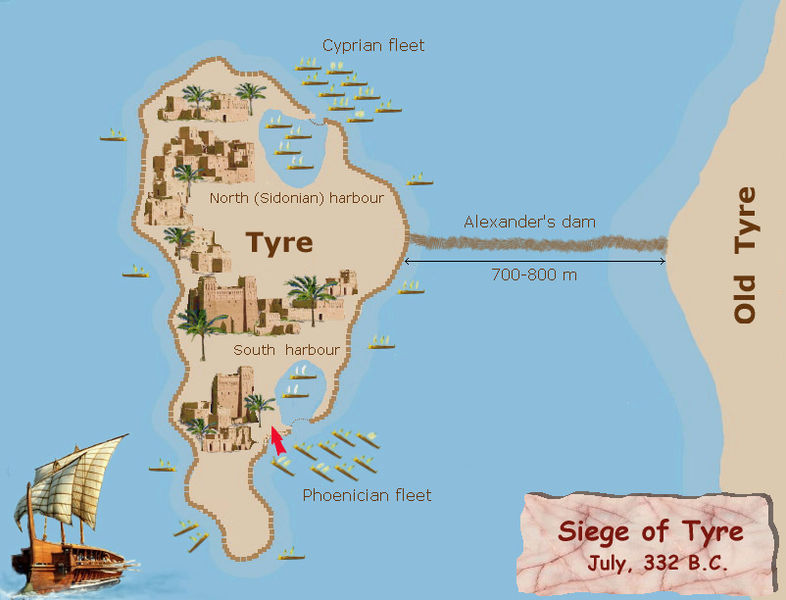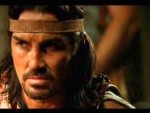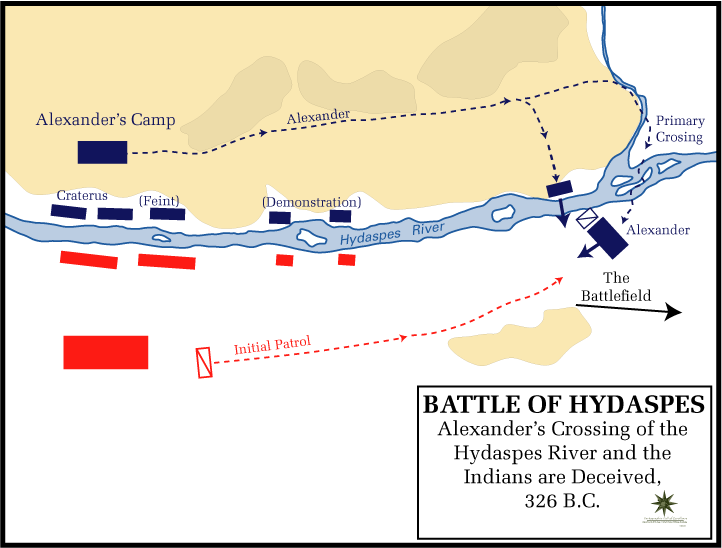The Campaign Of Alexander The Great (335-323 BC)

General knowledge testing on the histories of Alexander the Great.
- 1.
Greek General and mercenary commander for the Persians that led a successful counter insurgency against Alexander along the western port cities of Anatolia, in the city of Halicarnassus, and the Aegean Sea before his death in 334 BC.
- A.
Mentor of Rhodes
- B.
Azemilkos of Tyre
- C.
Memnon of Rhodes
- D.
Pixodaros
Correct Answer
C. Memnon of RhodesExplanation
After Memnon passed away unexpectedly, his son-in-law Pharnabazus took control of the Persian forces in the Aegean, assisted by Autophradates. Together they presented major problems to Alexander.Rate this question:
-
- 2.
Originally a commander under Philip II, in 334 BC Alexander appoints this future Diadochi member as Satrap of Greater Phrygia (western Anatolia) charging him with mopping up operations and quelling rebellions in the wake of his march east.
- A.
Hephaestion
- B.
Antigonus Monopthalmus
- C.
Perdiccas
- D.
Ptolemy
Correct Answer
B. Antigonus MonopthalmusExplanation
Alexander appoints Antigonus Monopthalmus as Satrap of Greater Phrygia in order to handle the aftermath of his march east. This suggests that Antigonus is trusted by Alexander to effectively manage the region, including suppressing rebellions and completing necessary operations.Rate this question:
-
- 3.
Name the battle depicted in this famous fresco discovered among the ruins of Pompeii showing Alexander the Great and King Darius in the thick of battle.
- A.
The Siege of Halicarnassus
- B.
Battle of Gaugamela
- C.
Battle of Issus
- D.
Battle of the Granicus River
Correct Answer
C. Battle of IssusExplanation
The correct answer is the Battle of Issus. The Battle of Issus was fought between Alexander the Great and King Darius III of Persia in 333 BC. The fresco discovered in Pompeii depicts this battle, showing Alexander and Darius in the midst of the conflict. The Battle of Issus was a significant victory for Alexander, as it resulted in the defeat of the Persian army and the capture of Darius's family.Rate this question:
-
- 4.
After achieving victory at the Battle of Issus in 333 BC Alexander quickly advances south through Syria towards Egypt. Nearly all coastal cities in the Levant submit to Alexander. Tyre, while giving every assurance they recognized the young Macedonian as the new master of the realm they refused repeated requests from Alexander to come onto the island. What pretense did Alexander use to warrant his visit?
- A.
To make a sacrifice at the Temple of Melqart, the Tyrian equivalent of Herakles.
- B.
To meet with King Azemilkos to discuss his appointment as Satrap over the Levant.
- C.
To search for Darius who was suspected of hiding in the city's citadel after his defeat at Issus.
- D.
To discuss plans for Tyre to bring Carthage back under its purview.
Correct Answer
A. To make a sacrifice at the Temple of Melqart, the Tyrian equivalent of Herakles.Explanation
Many contemporary scholars have critizised Alexander's 6 month seige of Tyre as unecessary. However it is important to know the significance Tyre played in helping to supply the Persian fleet which was still active in the Aegean and causing significant problems that threatened his supply lines. Capture of the city's harbor put an end to this threat.Rate this question:
-
- 5.
After lengthy sieges at Tyre (333/442) and Gaza(332), Egypt was a relative cake walk for Alexander to subjugate.
- A.
True
- B.
False
Correct Answer
A. TrueExplanation
Yes, Mazakes the Persian satrap offered only token resistance to Alexander and was less than enchanted with Darius's conduct at Issus years before. He offered only token resistance to Alexander along his route towards Babylon which he surrendered without a fight later, indicating he was also probably Satrap of that region as well.Rate this question:
-
- 6.
In the autum of 331 BC Alexander and Darius meet on a plain near the small villiage of Gaugamela, approximately 75 miles north of Arbela. Though heavily outnumbered, he chose to offer battle on terrain knowingly favorable to the Persians. What special weapon did Darius use against Alexander at Gaugamela that he ordered his men prepared the battlefield the night before being careful to remove rocks and other impediments?
- A.
Bactrian Dromedaries
- B.
War Elephants from India
- C.
Scythed Chariots
- D.
10,000 Immortal Soldiers
Correct Answer
C. Scythed ChariotsExplanation
Darius used Scythed Chariots against Alexander at Gaugamela. These chariots were equipped with blades or scythes attached to the wheels or axles, which were intended to cut down enemy soldiers as they charged. Darius ordered his men to prepare the battlefield the night before by removing rocks and other impediments to ensure that the chariots could maneuver effectively. The use of Scythed Chariots was a strategic attempt to counter Alexander's forces and gain an advantage in the battle.Rate this question:
-
- 7.
Which Egyptian God had an oracle located in the Oasis of Siwa that Alexander risked a 200 mile dessert crossing to consult? This god was considered the equivalent of the Greek God of Zeus, which Alexander believed was his actual father.
- A.
Bastet
- B.
Ammon-Ra
- C.
Osiris
- D.
Seth
Correct Answer
B. Ammon-RaExplanation
Settled in the west of Egypt this settlement is known to have been in existence since the 10th Century and came into contact with Pharonic Egypt sometime during the 26th Dynasty(c. 685-525 BC). The cult of Ammon-Ra became popular with the Greeks sometime in the 5th Century, probably through colonists from Cyrene.Rate this question:
-
- 8.
This cavalry commander served under Darius during the Battle of Gaugamela and was Satrap of Bactria before mortally wounding and leaving for dead the Great King as he fled east. This would be an offense Alexander would not let pass finally having him killed a year later.
- A.
Spitamenes
- B.
Satibarzames
- C.
Bessus
- D.
Dataphernes
Correct Answer
C. BessusExplanation
Bessus was a cavalry commander who served under Darius during the Battle of Gaugamela. He was also the Satrap of Bactria. After Darius was mortally wounded and fled east, Bessus betrayed him by capturing and leaving him for dead. Alexander, who was pursuing Darius, considered this betrayal as a grave offense and later had Bessus killed as a punishment.Rate this question:
-
- 9.
In the autumn of 328 BC Alexander murders his friend and officer during a drunken argument at a drinking party somewhere in Marakanda. Name this general that once saved the life of Alexander the Great during the Battle of Granicus river from Spithradates. Gary Stretch playing the role of *********** in the 2004 film adaptation of Alexander
- A.
Cleitos the White
- B.
Cleitos the Black
- C.
Craterus
- D.
Kleomenes
Correct Answer
B. Cleitos the BlackExplanation
Though the actual reasons behind Alexander's murder of Cleitos are uncertain it is believed Cleitos did not approve of Alexander's recent adoption of Persian customs and dress and made his feelings be known in no uncertain terms during a drinking party which had fatal results for this member of the royal somatophylakes, or bodyguard.Rate this question:
-
- 10.
Name of the stone fortification in the Pareitakene region of Sogdiana at the foothills of the Indian Caucasus that Oxyartes, the brother of Darius, kept his wife and daughter (Roxana) while off organizing resistance against Alexander's advance.
- A.
Aornos Rock
- B.
Mt. Meros
- C.
Fort Oxus
- D.
Sogdian Rock
Correct Answer
D. Sogdian RockExplanation
The Sogdian Rock's defenders were very confident of the stronghold's ability to withstand attack, boasting to Alexander's men that they had better have wings if they wished to take the fortress. While his men did not possess the ability to fly they did scale the steep cliffs of the installation and Alexander took the fortress in the end.Rate this question:
-
- 11.
Alexander's attack on Indian King Porus required him to divide his army and land half of his army on the eastern side of the Hydaspes River further up stream to capture the element of surprise. Alexander accomplishes this by quickly building a large bridge over the river which enabled the logistics of his plan and struck awe and fear in the ranks of the Indian tribes.
- A.
True
- B.
False
Correct Answer
B. FalseExplanation
False. Alexander's plan to defeat Porus hinged greatly on the element of surprise. Building a bridge Ceasar style (a'la the Rhine River) would not have acheived this. Alexander led a large task force further up the Hydaspes River crossing a shallow ford, but quickly discovered to his horror he had led his men onto an island in the middle of the river! Dispite this, he was able to cross to the eastern bank with the bulk of his men and bring the battle to Porus in the south as planned.Rate this question:
-
- 12.
Name the Indian tribal clan that offered fierce resistance against Alexander as he grugingly headed south towards the source of the Indus River after his men threatened to mutiny if they continued their easterly march.. It was while fighting this faction that he received a near fatal arrow shot in the lung after storming over the walls of a fortified town.
- A.
Malloi
- B.
Ossadians
- C.
Kathaioi
- D.
Xathrians
Correct Answer
A. MalloiExplanation
It was said that Alexander never fully recovered from his injury fighting the Malloi.Rate this question:
-
- 13.
Alexander sped up his westward journey to Babylon by constructing a naval fleet to sail his entire army back home, skirting the costline towards the Persian Gulf.
- A.
True
- B.
False
Correct Answer
B. FalseExplanation
While Nearchus did construct a fleet which he used to transport Alexander's men, the bulk of his army traveled west in two seperate caravans over land. Alexander led one across the Gedrosian desert suffering great loss of life. Crateros lead the second caravan using a more northerly route traveling through Arachosia and Drangiana.Rate this question:
-
- 14.
On his return approach to Babylon, Chaldaean soothsayers took Alexander aside referencing a prophecy from priests of the city's patron god Marduk suggesting he should return through the city's _________ gate and not the __________ gate that he ultimately chose.
- A.
North, South
- B.
West, East
- C.
South, North
- D.
East, West
Correct Answer
D. East, WestExplanation
The Babylonians were a deeply religious people and held on to certain superstitions and customs regarding protocol that dated back thousands of years.Rate this question:
-
- 15.
Whose death a half year before Alexander's own passing caused him inconsolable grief that he would never fully recover from?
- A.
Nerchus
- B.
Perdiccas
- C.
Ptolemy
- D.
Hephaistion
Correct Answer
D. HephaistionExplanation
Alexander the Great had a close and deep bond with his childhood friend and companion, Hephaistion. When Hephaistion died six months before Alexander's own passing, it caused him immense grief. Alexander was devastated by the loss of his dear friend and never fully recovered from this loss. The death of Hephaistion had a profound impact on Alexander, highlighting the depth of their relationship and the emotional toll it took on him.Rate this question:
-
- 16.
Alexander was working on an expedition to what region while taking up residence in Babylon in 323 BC?
- A.
Armenia
- B.
Scythia
- C.
The return to India
- D.
Arabia
Correct Answer
D. ArabiaExplanation
This is a painting of Alexander's original entrance into Babylon almost a decade earlier in 331 BC.Rate this question:
-
- 17.
According to the Royal Journals, (a series of documents possibly maintained by Eumenes), many of his generals reportedly spent the last night of Alexander's life in the temple of Serapis, seeking the god's advice regarding his grave illness and what to do next. What is flawed about this journal entry?
- A.
They sought the guidance of Ammon-Ra who was reportedly Alexander's father.
- B.
They would have been in Marduk's temple as he was the post powerful god in the Babylonian pantheon.
- C.
Serapis was a cult began by Ptolemy after he set up his rule in Egypt. It was a conveinent fusion of Greek and Egyptian religions and served to spread harmony between the ruling Greeks and their Egyptian subjects.
Correct Answer
C. Serapis was a cult began by Ptolemy after he set up his rule in Egypt. It was a conveinent fusion of Greek and Egyptian religions and served to spread harmony between the ruling Greeks and their Egyptian subjects.Explanation
Assuming the role as Pharoh, Ptolemy was careful to hit the right balance between Egypt's pharaonic past and his own Hellenic background.Rate this question:
-
- 18.
Which Macedonian was named regent of the empire after the death of Alexander during the contentious Settlement of Babylon while awaiting the birth of Alexander's unborn child with Roxana?
- A.
Antipater
- B.
Ptolemy
- C.
Perdiccas
- D.
Polyperchon
Correct Answer
C. PerdiccasExplanation
Perdiccas's star had been on the rise with Alexander during the last few years of his reign. However, few if any of Alexander's successors enjoyed a sizable advantage over their counterparts with respect to "gravitas" and the like that might have otherwise made choosing an unambiguous heir easier. As such from the beginning Perdiccas lacked the respect and allegance of his fellow Macedonian officers that his high office would necessitate to administer the empire and quickly led to internal conflict between the Diadochs.Rate this question:
-
Quiz Review Timeline +
Our quizzes are rigorously reviewed, monitored and continuously updated by our expert board to maintain accuracy, relevance, and timeliness.
-
Current Version
-
Mar 21, 2023Quiz Edited by
ProProfs Editorial Team -
Jan 23, 2011Quiz Created by
HCQuizmaker
 Back to top
Back to top




















